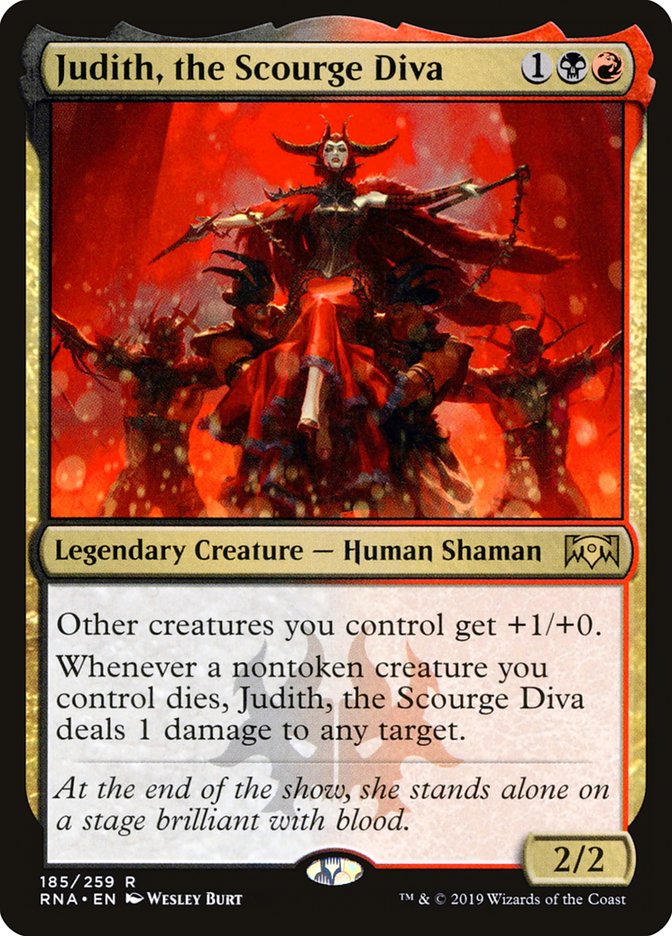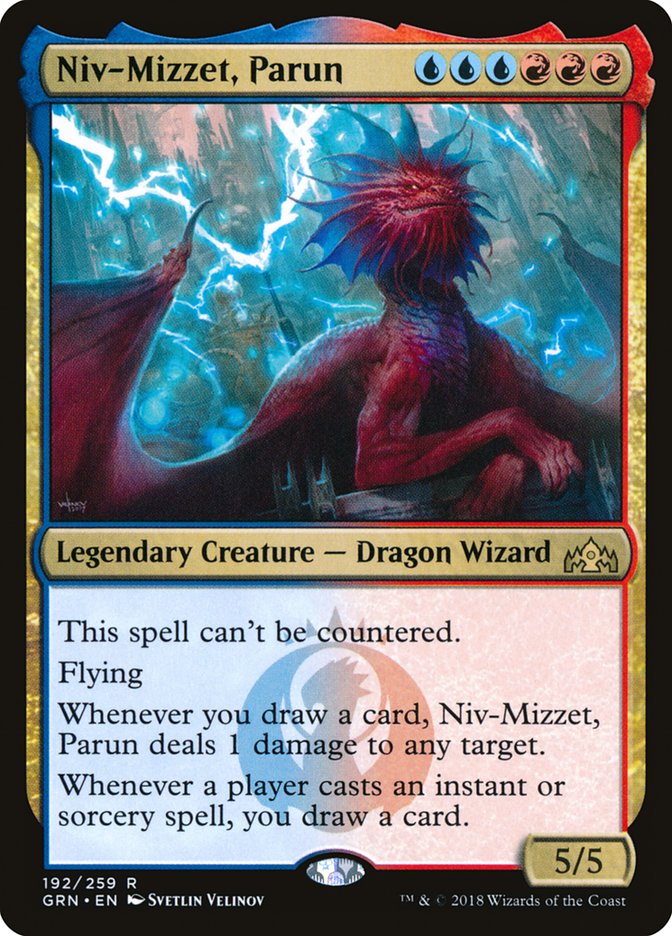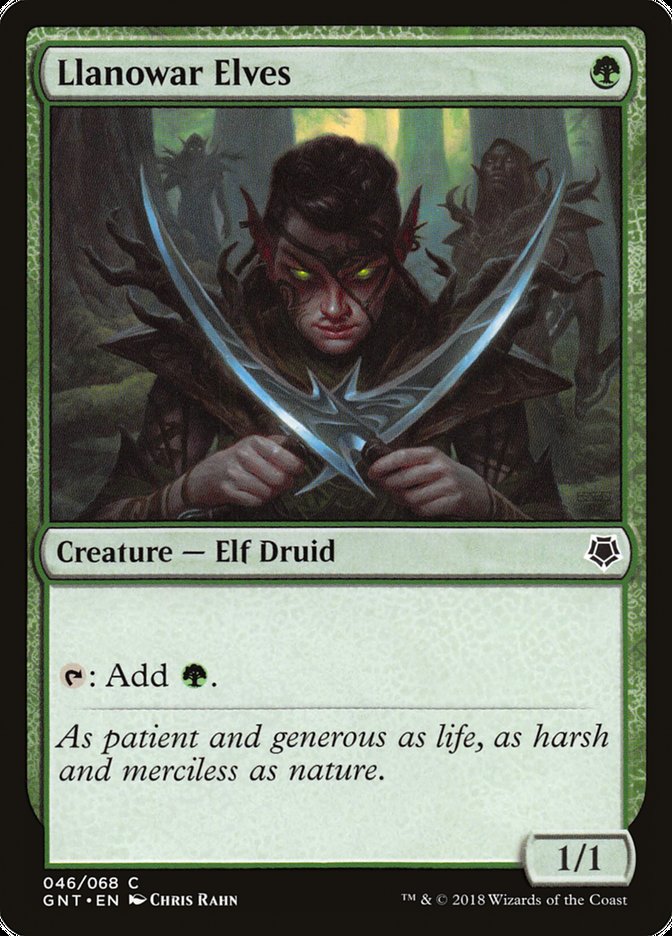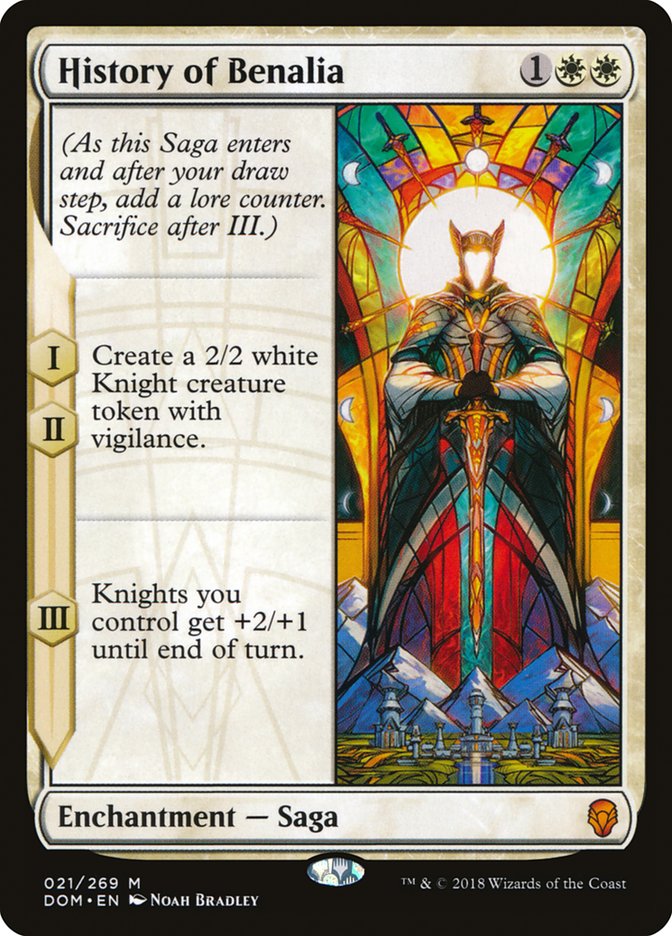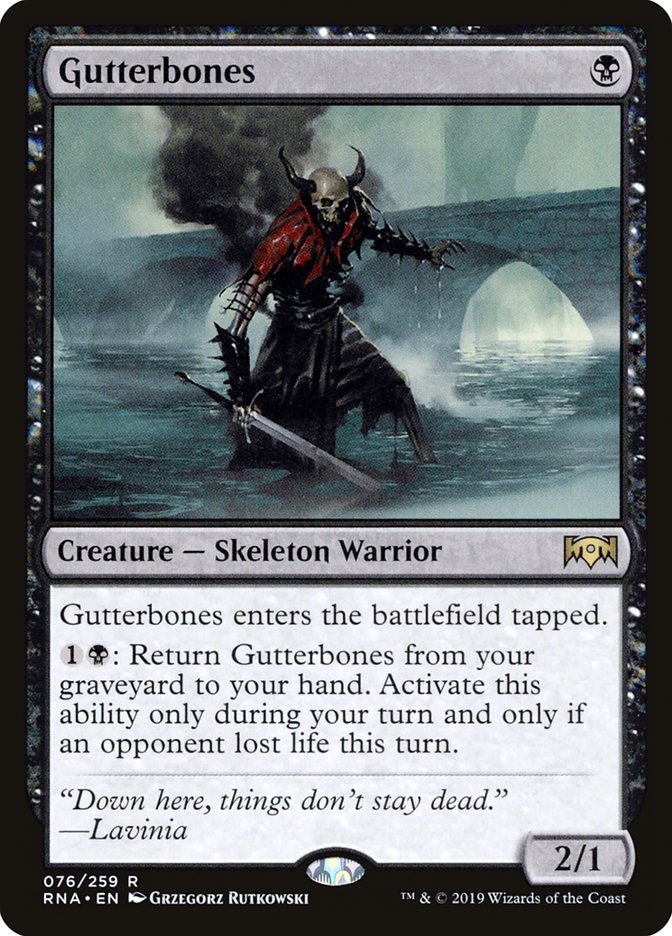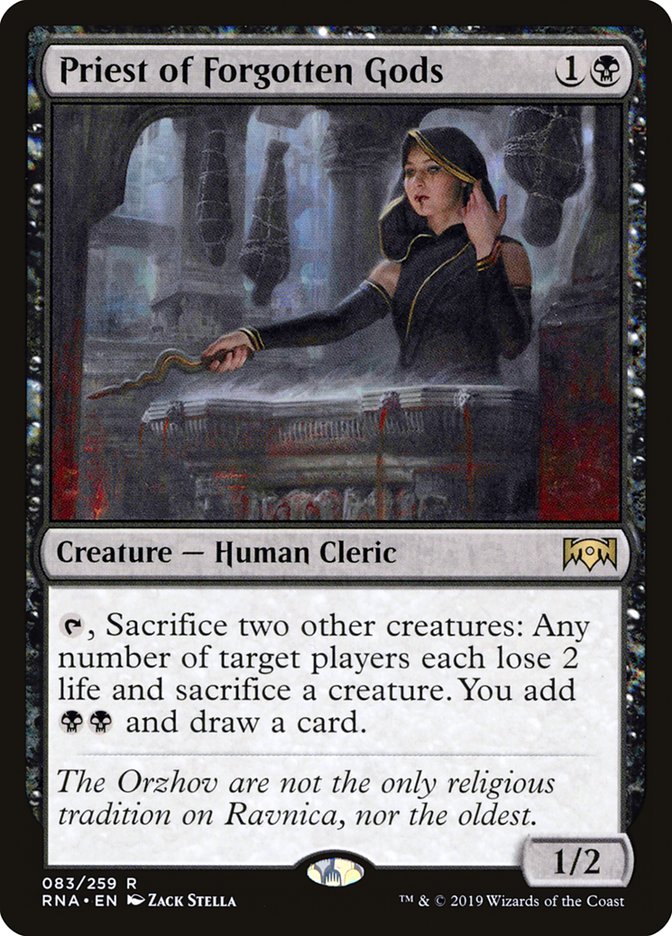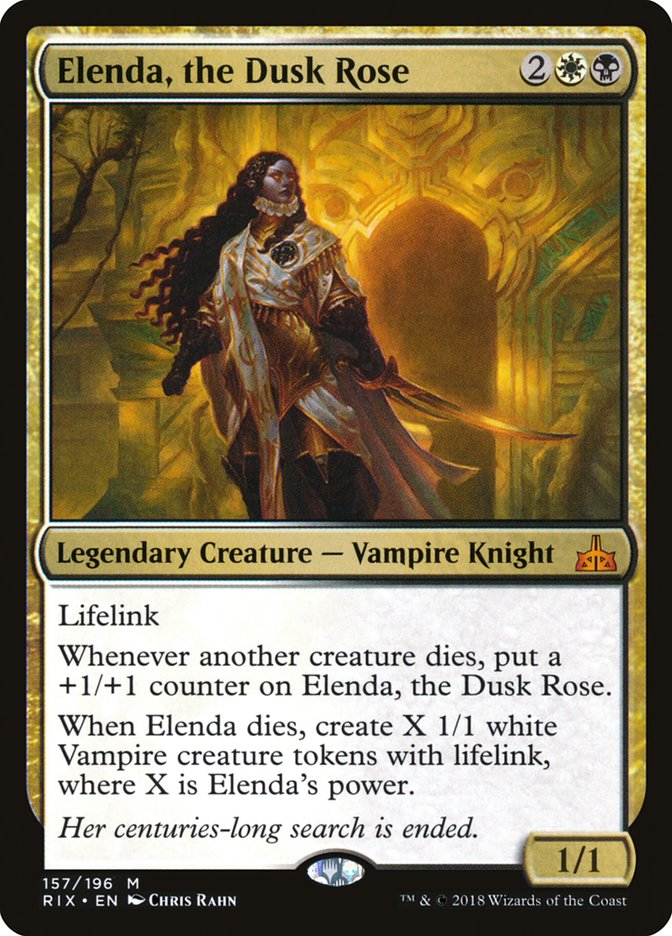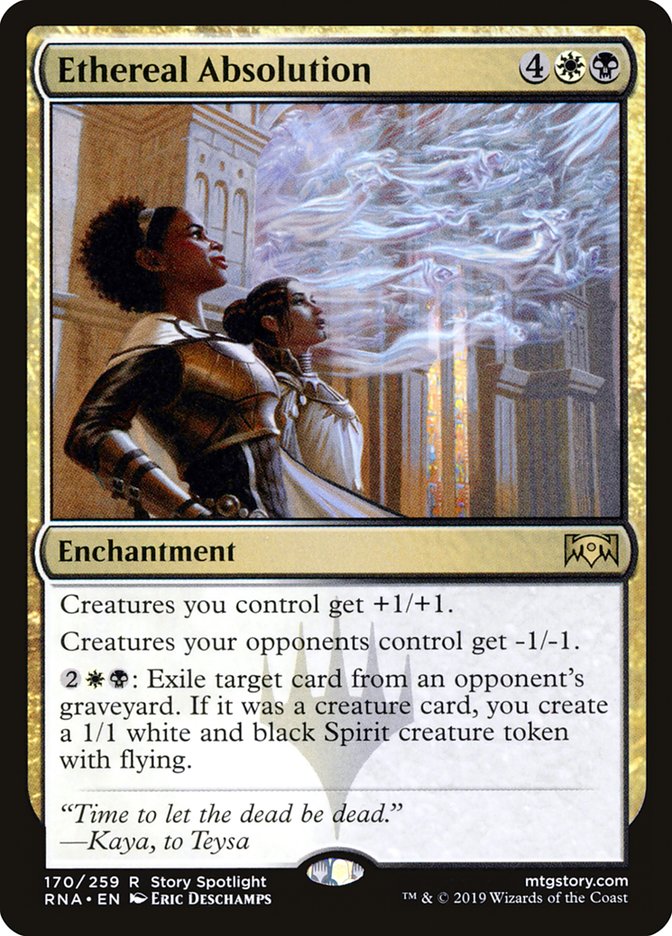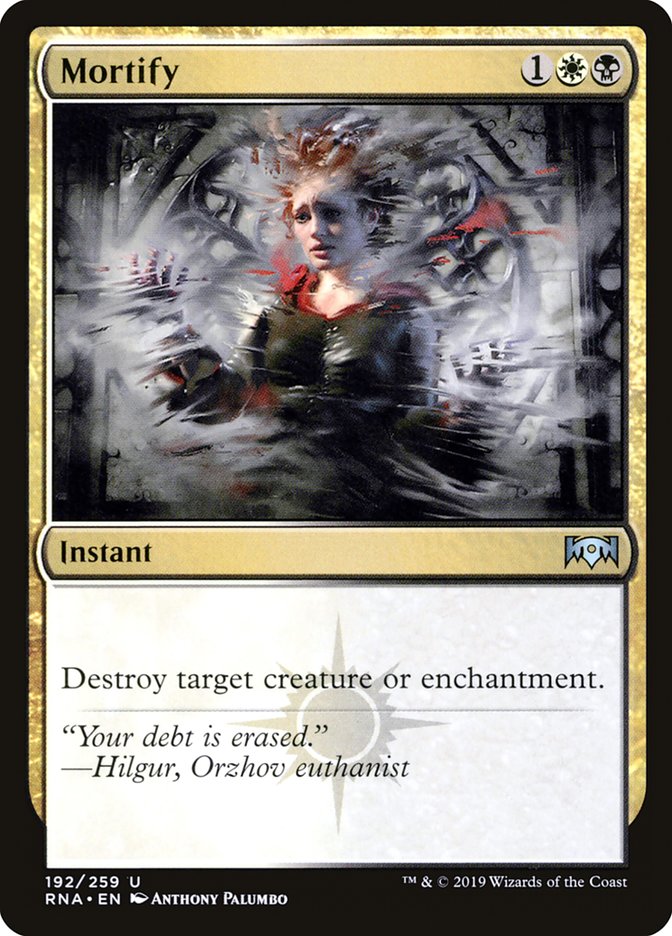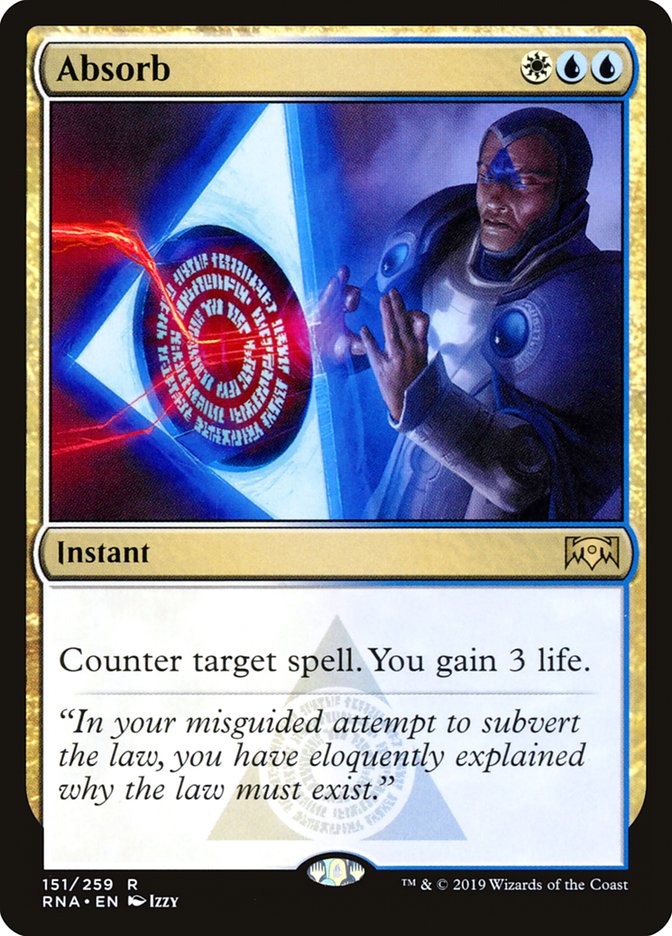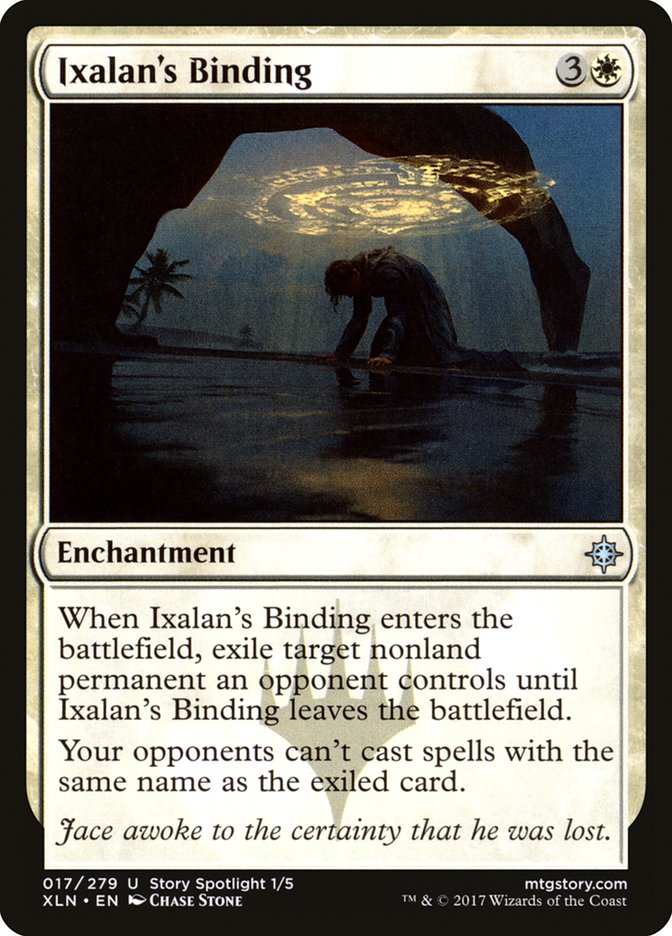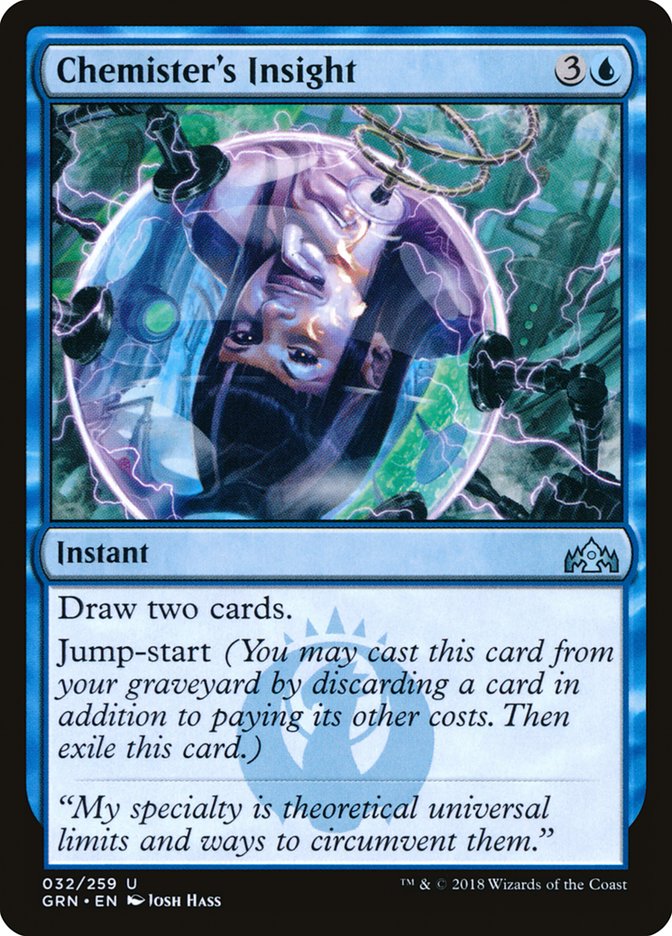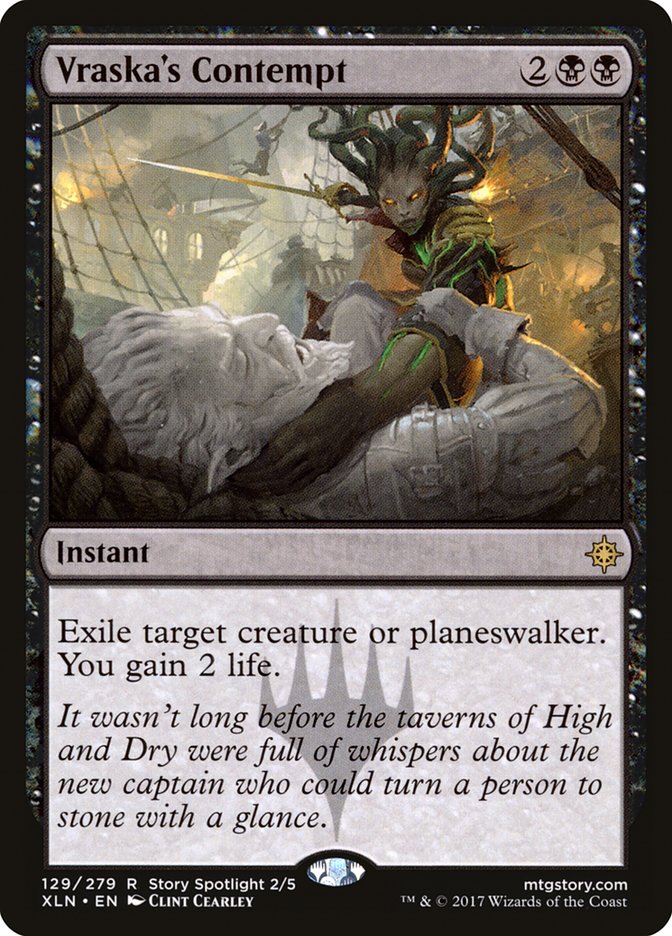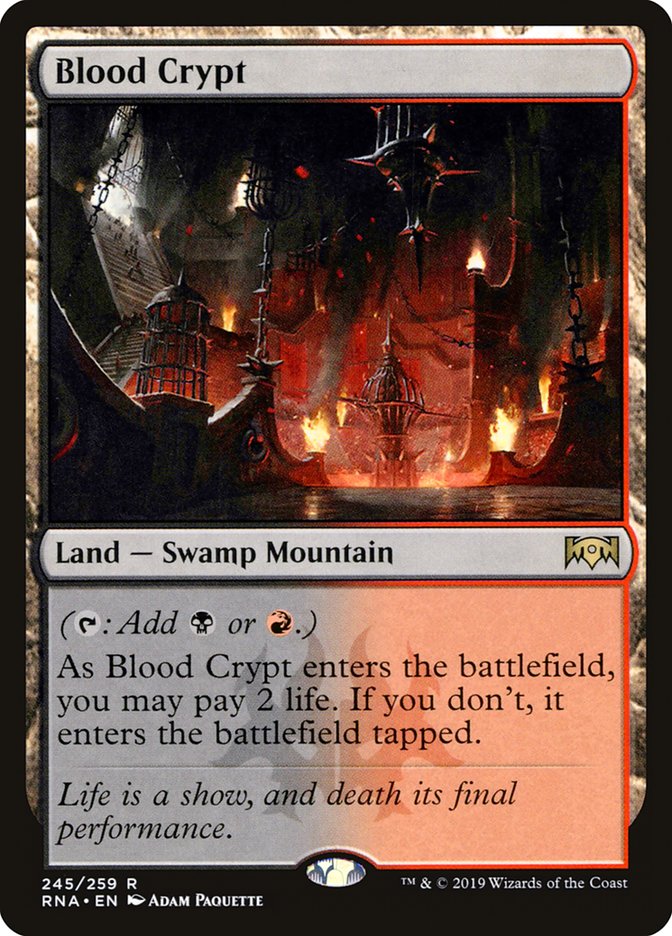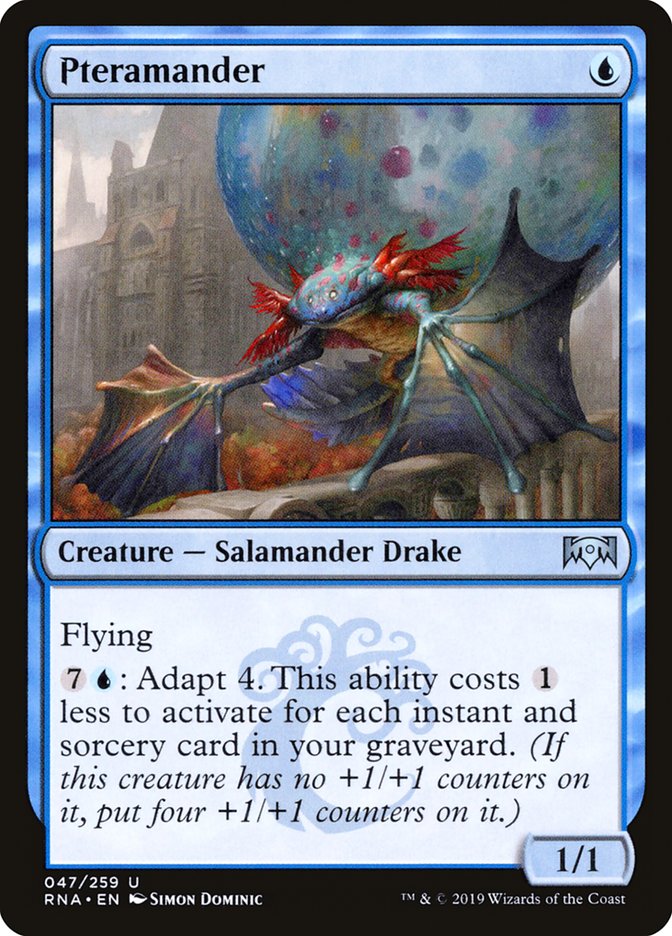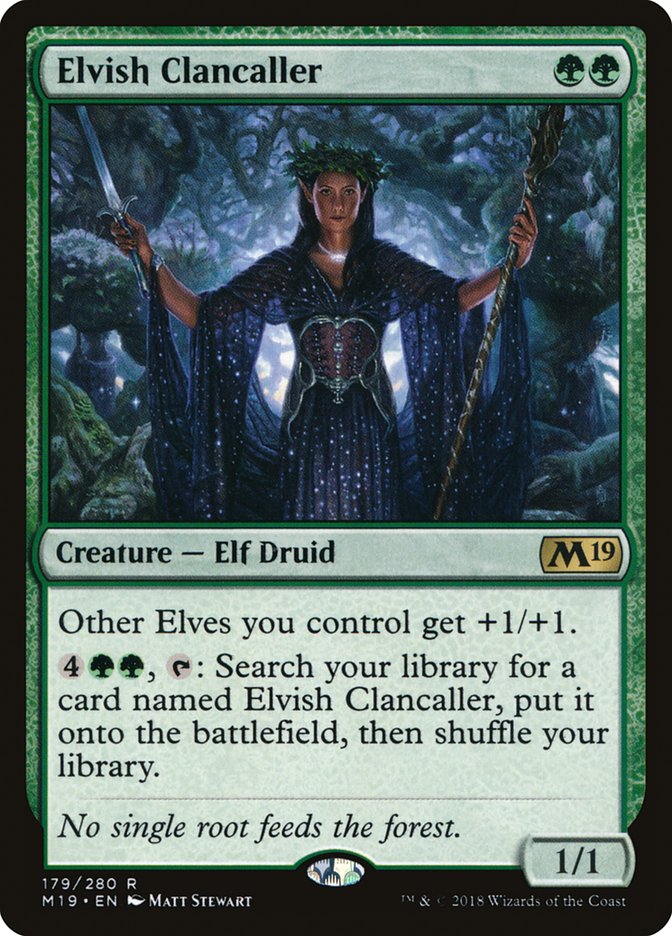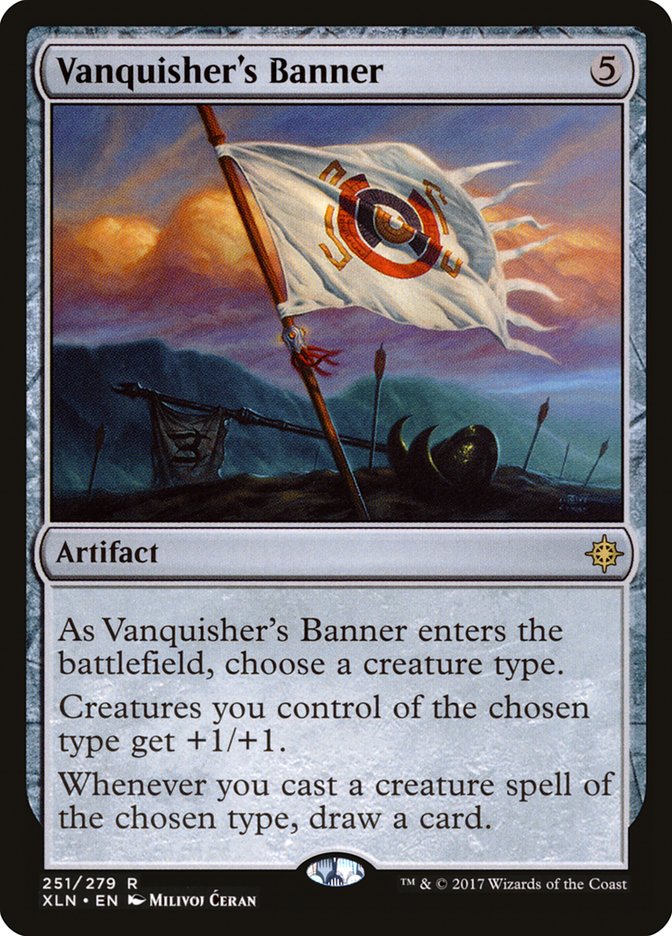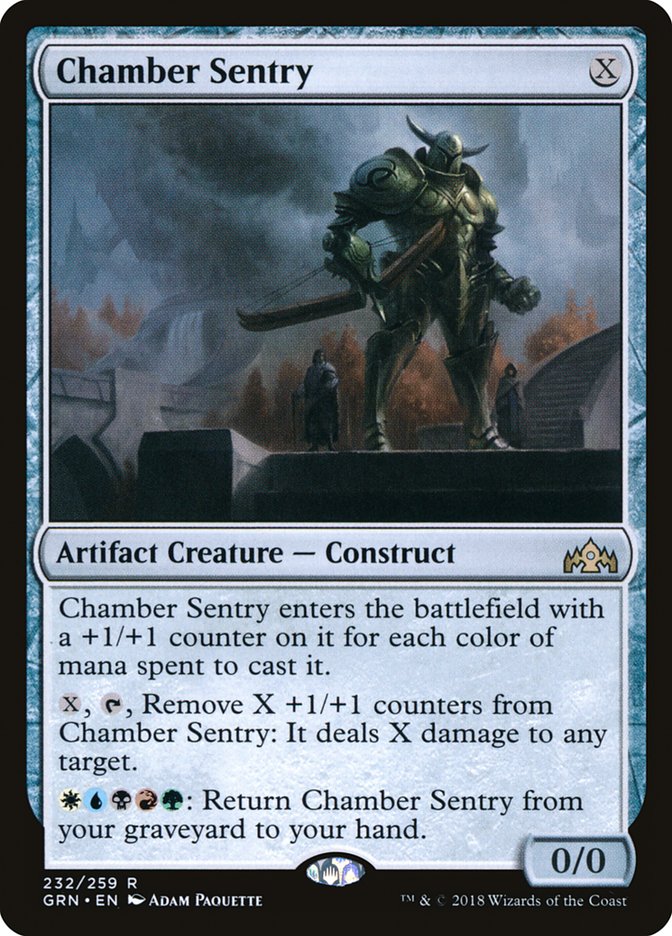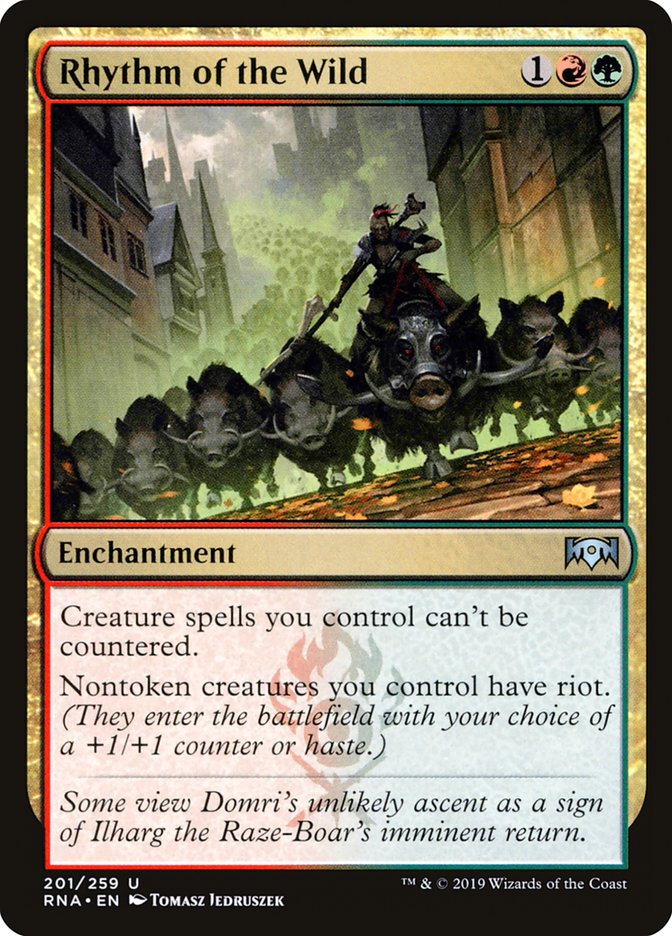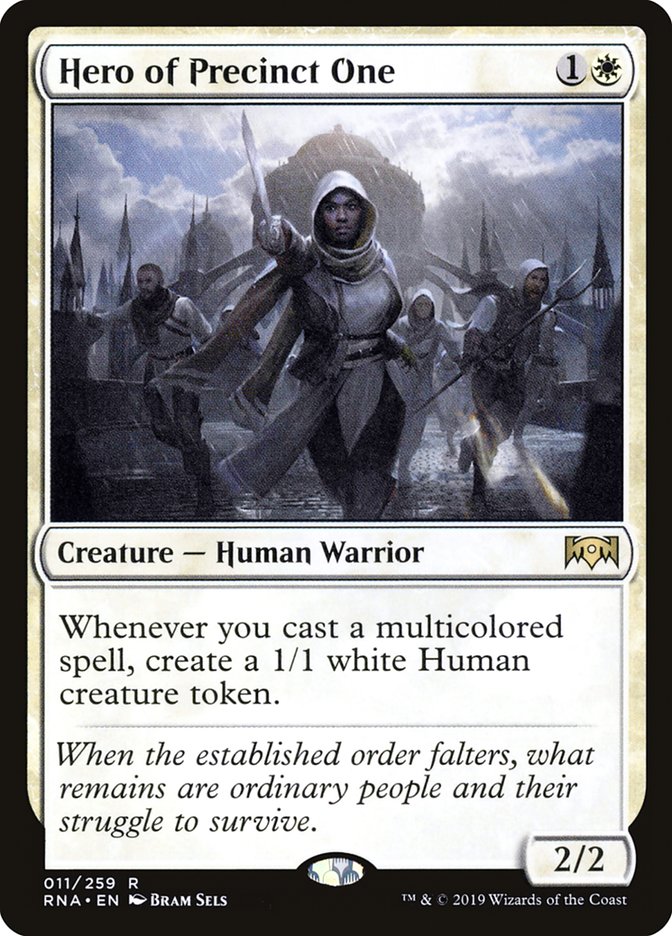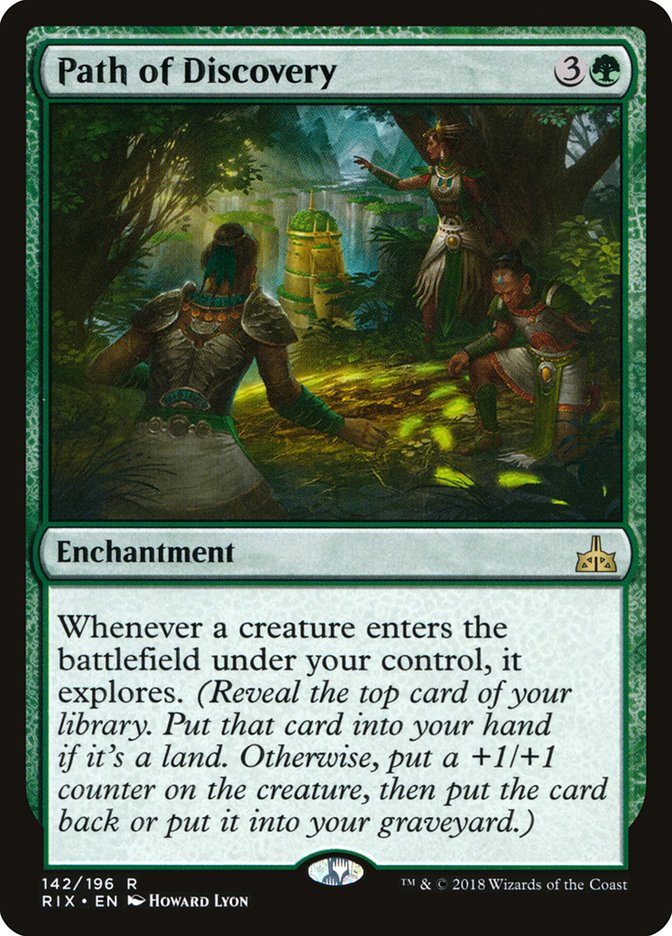Cedric didn’t believe me when I told him my article topic.
Him:
Well, if you think you can come up with 20 good decks…
Me:
C’mon man, I already have all 20 built.
Him:
*Pikachu meme*
With Ravnica Allegiance, there are six pillars of Standard:
Realistically, your deck needs a good reason to not contain one of those
six cards in your 75. You could make some arguments for semantics’ sake
about how not all Izzet decks will focus on Niv-Mizzet, Parun or how not
all red decks will contain Goblin Chainwhirler, and that’s probably true.
However, you will get more mileage from building around those cards than
you would, say, Arclight Phoenix or Skewer the Critics. It’s possible that
both of those entities could be combined into “Lava Coil” decks, but most
red decks would play them in their sideboard.
Anyway, let’s start with the new one.
Judith, the Scourge Diva
Given that most cards in these decks are from Ravnica Allegiance,
it’s difficult to build these decks optimally without getting some
practice. Thankfully, we’ll have the opportunity to do so on Magic Arena by
the time this article goes live!
Creatures (29)
- 3 Dusk Legion Zealot
- 2 Goblin Instigator
- 2 Dark-Dweller Oracle
- 2 Midnight Reaper
- 2 Plaguecrafter
- 2 Rix Maadi Reveler
- 4 Judith, the Scourge Diva
- 4 Gutterbones
- 4 Priest of Forgotten Gods
- 4 Footlight Fiend
Planeswalkers (1)
Lands (17)
Spells (13)

The Rakdos versions of Aristocrats that people played during the MTG Arena
streamer event seemed to be more on the aggressive side, with Spawn of
Mayhem, Fireblade Artist, and the like. Overall, I’m not as much of a fan
of that plan. Priest of Forgotten Gods and Judith, the Scourge Diva are the
all-stars of these sorts of decks, and both play well with a grindier
gameplan. Meanwhile, Spawn of Mayhem and Fireblade Artist haven’t impressed
very much. If I wanted to build an aggressive deck, I likely wouldn’t have
those cards in it to begin with.
Anyway, this deck wins by accruing value. Given the tools we have available
to us now, it’s hard to get it wrong. There are so many value creatures,
sacrifice effects, and payoffs that it also seems trivial which ones you
actually play. That said, some number of Gutterbones, Priest of Forgotten
Gods, and Judith aren’t cuttable as they form your main engine.
Past that, how many sacrifice outlets do you want? If you want to double up
on pings from Judith and Footlight Fiend to clear small or medium
creatures, maybe Makeshift Munitions if what you want. Do you think you
need staying power? Then you should have Dark-Dweller Oracle, Midnight
Reaper, and Theater of Horrors. How much removal do you need?
After sideboard, we have Angrath, the Flame-Chained finally stepping into
the spotlight. Maybe there needs to be more sacrifice effects to truly take
advantage of him, but he doubles as a threat against midrange and control
decks too. Drill Bit seems like a pretty easy piece of disruption for the
deck to play, since you’ll often be attacking for small chunks of damage
against opponents with no blockers. Midnight Reaper solidifies those
matchups because it’ll be difficult for you to run out of resources, but
there’s also an Arch of Orazca to draw cards and help with the higher mana
curve.
Creatures (29)
- 3 Elenda, the Dusk Rose
- 2 Midnight Reaper
- 4 Judith, the Scourge Diva
- 4 Pitiless Pontiff
- 4 Gutterbones
- 4 Hero of Precinct One
- 4 Priest of Forgotten Gods
- 4 Footlight Fiend
Lands (24)
Spells (7)

I’m honestly not sure which is stronger between Mardu and Rakdos, but
either way, the combination of Judith and Priest of Forgotten Gods is a
strong one. Mardu is basically just a fancier Rakdos, for better or for
worse. You’ll have worse mana, slightly better toys, but a few incredibly
impactful cards like Elenda, the Dusk Rose, Mortify, and Ethereal
Absolution (which is a complete mirror breaker).
You can build around Hero of Precinct One, which I’ve elected to do here,
but it’s not entirely necessary. Tithe Taker would be a fine replacement.
If you want to stay on the Hero’s journey, you could look into playing some
of number of Heroic Reinforcements.
You could build a more aggressive Mardu deck with Heroic Reinforcements and
even utilize the power of Unclaimed Territory for Benalish Marshal if you
wanted to. Either way, your deck doesn’t have to be all-in on sacrifice
effects to make Judith powerful. Simply attacking is a fine way to ensure
your opponent’s life is hard. She doesn’t trigger on tokens dying, but
pumping them is a nice bonus.
Teferi, Hero of Dominaria
Creatures (1)
Planeswalkers (4)
Lands (10)
Spells (45)

We all thought we’d get Supreme Verdict, Detention Sphere, and Sphinx’s
Revelation this time around, right? Well, jokes on us because Azorius
Control picked up roughly zero cards. Granted, Hallowed Fountain is great,
but that’s the floor of what we thought we’d get.
Honestly though, it’s fine. The Azorius Control kit was already strong, and
it’s not like Absorb is nothing. My main issue is that we don’t get an
upgrade to Ixalan’s Binding since it and Chemister’s Insight tend to be too
clunky, but oh well.
There’s not much you can do to innovate here outside of tweaking some
numbers. I prefer having Opt and a lower land count and Warrant over Seal
Away, mostly because of Search for Azcanta. The sideboard could be more
creative I suppose, but the options are slim.
For the first time ever, I actually prefer Esper Control to Azorius
Control.
Creatures (1)
Planeswalkers (4)
Lands (27)
Spells (28)
- 3 Absorb
- 2 Syncopate
- 2 Mortify
- 1 Negate
- 3 Vraska's Contempt
- 3 Moment of Craving
- 2 Cast Down
- 4 Thought Erasure
- 2 Notion Rain
- 1 Precognitive Perception
- 1 Consecrate
- 4 Kaya's Wrath
Sideboard

Naturally, I started by looking at Shaheen Soorani’s take on Esper Control.
Basic Island isn’t very acceptable in a deck with Kaya’s Wrath. You could
get around needing additional blue sources by not playing Absorb, but I
think most of the control players will want access to a hard counterspell.
Absorb also tag teams with Moment of Craving and Vraska’s Contempt to ease
some of the strain off your manabase.
Esper Control straddles this awkward line between tap-out control and
normal control, which doesn’t make for the most synergetic experience, but
you’ll get spots to use your countermagic, even if they are effectively
face-up. Thought Erasure into Kaya’s Wrath is so strong that I’m willing to
jump through whatever hoops it takes to make this deck viable.
Creatures (2)
Planeswalkers (1)
Lands (12)
Spells (45)
- 6 Forest
- 8 Island
- 4 Opt
- 3 Search for Azcanta
- 3 Blink of an Eye
- 2 Grow from the Ashes
- 4 Nexus of Fate
- 4 Root Snare
- 2 Chemister's Insight
- 4 Growth Spiral
- 1 Precognitive Perception
- 4 Wilderness Reclamation
Sideboard

All this deck does is ramp, draw cards, and eventually take all the turns.
I had the pleasure of watching Eric Froehlich stream something like this
and it honestly looked kind of busted. Not many decks can threaten to kill
you on Turn 4, and those that do are typically trying to get up a big turn
where a Root Snare will be devastating.
Including this in the Teferi section is cheating because it doesn’t
actually have Teferi in it, but I’d argue that Teferi is with this deck in
spirit.
Niv-Mizzet, Parun
Creatures (10)
Lands (23)
Spells (27)
- 3 Island
- 4 Shock
- 4 Opt
- 2 Syncopate
- 2 Dive Down
- 2 Blink of an Eye
- 1 Expansion
- 4 Lava Coil
- 4 Growth Spiral
- 1 Precognitive Perception
Sideboard

I didn’t see many decks with Frilled Mystic in them during the streamer
event, so I’ve been busy trying to mend my broken heart. Make no mistake,
Frilled Mystic will be a player in Standard, and this seems like one of the
better shells that could make it happen.
Prolong the game and protect Niv-Mizzet, Parun is a viable strategy,
whether you’re trying to do it with Enigma Drake, Deafening Clarion, or
Frilled Mystic. It also helps that this deck isn’t weak to any of the
things that Niv is weak too, such as Vivien Reid or Plaguecrafter. Against
Drakes, loading up on those effects was lights out, but they barely do
anything against this version.
A faster version that eschews the whole Niv plan for Risk Factor maindeck
and Gruul Spellbreakers out of the sideboard could be nice too, especially
when backed up by a couple copies of Banefire.
Creatures (10)
Planeswalkers (4)
Lands (24)
Spells (22)

We can finally put Niv and Vraska’s Contempt in the same deck! That might
not be the strongest combination Blood Crypt enables, but it will likely be
one of the most beloved.
Between Thought Erasure, Carnage, and Bolas, this deck has a good amount of
disruption. There are some dead cards against control decks, but disruption
plus a clock can still beat them. As always, the Dimir sideboard options
give you an endless array of tools for fighting control. For the moment, it
seems like your best bet is trying to go toe-to-toe with the aggressive
decks in Game 1, which Grixis is typically great at.
Dragon-centric decks have popped up here and there since Guilds of Ravnica, but now is its chance to actually put up a big
finish.
Creatures (13)
Lands (8)
Spells (39)

Niv lives in the sideboard here, but the way you built Izzet had to be
fluid, shifting week to week to combat the metagame, and this is no
different.
Pteramander works well enough with the Arclight Phoenix plan that it’s
probably better than playing a ton of Drakes, plus it enables Chart a
Course early if that’s something you’re interested in. It does pull you in
the direction of playing all the one-mana cantrips, but that’s not
necessarily a negative thing.
Trying to do your best Delver of Secrets impression in Standard is
naturally going to lead you away from the glory that is Niv-Mizzet as you
shift from midrange-leaning tempo deck to beatdown-leaning tempo deck, but
both are okay.
Llanowar Elves
Creatures (21)
- 4 Llanowar Elves
- 2 Emmara, Soul of the Accord
- 3 Trostani Discordant
- 4 Deputy of Detention
- 4 Frilled Mystic
- 4 Hero of Precinct One
Planeswalkers (3)
Lands (19)
Spells (17)
Sideboard

This is somewhat of a departure from
my Frilled Mystic article last week
, but I like the way this deck looks as less flash and more Selesnya. Any
endgame consisting of March of the Multitudes alongside Trostani Discordant
is fairly incredible, and that’s certainly something I was missing with the
Bant Tempo deck. March of the Multitudes isn’t particularly impressive as a
punish for not walking into Frilled Mystic. If you have enough resources
that March would be for a lot, they are probably forced to play into you
regardless.
Anyway, this deck is great.
Creatures (27)
- 4 Llanowar Elves
- 3 Carnage Tyrant
- 4 Steel Leaf Champion
- 4 Pelt Collector
- 4 Growth-Chamber Guardian
- 4 Frilled Mystic
- 4 Incubation Druid
Lands (12)
Spells (21)
Sideboard

I fully expect a more normalized version of Elves to be relatively popular
since it finally has enough cards to be playable. However, Elvish
Clancaller and Vanquisher’s Banner aren’t necessarily doing anything more
powerful than abusing Incubation Druid and/or Hadana’s Climb. Additionally,
Carnage Tyrant is basically the best top end green has to offer, and it
only gets stronger with the addition of counterspells.
Is Chamber Sentry out of the sideboard too cute for small creature decks
like Aristocrats and the various white aggressive decks? You get a lot of
help getting extra counters from Hadana’s Climb, plus Unclaimed Territory
with Incubation Druid can get you a lot of colors. It might be too cute, so
perhaps racing with Pause for Reflection is a better plan.
Creatures (31)
- 4 Llanowar Elves
- 4 Marwyn, the Nurturer
- 4 Steel Leaf Champion
- 4 Elvish Clancaller
- 3 Beast Whisperer
- 4 Pelt Collector
- 4 Growth-Chamber Guardian
- 4 Incubation Druid
Lands (12)
Spells (17)
Sideboard

This is where people will end up when they sit down to build Elves and it’s
one of the reasons why I want access to Disenchants in my decks. Rhythm of
the Wild is terrifying, especially in conjunction with Growth-Chamber
Guardian. Since this deck is trying to get an engine online and draw a
bunch of cards, Rhythm of the Wild rarely feels like you’re down a
resource.
I like the idea of using Pause for Reflection in the creature mirrors that
come down to racing. Cindervines is a bad Disenchant, but it doubles as
hate for any sort of Turbo Fog deck too. Big, uncounterable spells come out
of the sideboard to punish control players who will lean on their sweepers
in order to beat you. Good luck beating Carnage Tyrant with haste!
For all intents and purposes, Unclaimed Territory is a basic Forest that
happens to tap for red mana when you have an Incubation Druid. There’s an
incredibly low amount of corner case scenarios where it could be worse than
an actual Forest, but it’s so miniscule that Unclaimed Territory seems
better.
Creatures (23)
- 4 Llanowar Elves
- 3 Carnage Tyrant
- 4 Wayward Swordtooth
- 4 Gruul Spellbreaker
- 4 Growth-Chamber Guardian
- 4 Incubation Druid
Lands (8)
Spells (29)
Sideboard

This is a weird one to say the least. Still, Experimental Frenzy and
Wayward Swordtooth are a perfect match. Your early aggression from
Growth-Chamber Guardian and Gruul Spellbreaker should put your opponent on
the backfoot, giving you a window to resolve an engine. From there, it’s
just a matter of finding one of your big ways to end the game.
Creatures (28)
- 4 Llanowar Elves
- 4 Nullhide Ferox
- 4 Kraul Harpooner
- 4 Pelt Collector
- 4 Gruul Spellbreaker
- 4 Skarrgan Hellkite
- 4 Growth-Chamber Guardian
Lands (8)
Spells (24)
Sideboard

Oddy enough, Domri might not see a ton of play, as Rhythm of the Wild seems
to be overshadowing him, at least for now. Giving your creatures riot is
powerful, but having a cheaper, harder to remove version is stronger, even
when you factor in the fact that Domri can draw cards.
You should probably think of this deck like the Mono-Green Aggro decks that
didn’t quite get there. Except, instead of not having any sort of reach
whatsoever, now the deck has a bunch of card advantage and haste. To top it
off, it has a real sideboard now.
Creatures (25)
- 4 Llanowar Elves
- 4 Wildgrowth Walker
- 2 Merfolk Branchwalker
- 4 Jadelight Ranger
- 4 Trostani Discordant
- 3 Deputy of Detention
- 4 Hero of Precinct One
Lands (20)
Spells (15)

Anyone remember that one week where this deck was actually good? Tulio
Jaudy might get very angry at me for butchering his masterpiece, but it’s
worth trying.
My love affair with Hero of Precinct One continues, mostly because of how
powerful it is alongside Path of Discovery. The Path / Trostani / March
endgame used to trump everything, and while that may no longer be the case,
it’s going to be good enough against most of the format.
If nothing else, you have blue cards to fight control and Wildgrowth Walker
to fight aggro. Maybe that’s good enough?
Goblin Chainwhirler
Creatures (20)
Lands (8)
Spells (32)
Sideboard

Rix Maadi Reveler is the additional piece we needed to play Arclight
Phoenix in non-blue decks. You could do more with this sort of deck too,
like relegate Goblin Chainwhirler to the sideboard or cut it entirely if
you wanted additional black cards. Runaway Steam-Kin isn’t a sacred cow
either, but it’s difficult to convince me to cut it when there are all the
cantrips.
Unfortunately, spectacle doesn’t play particularly well with Arclight
Phoenix, otherwise cards like Light up the Stage and Skewer the Critics
would be exciting. Someone might make a version of this deck that’s
legitimately great.
Creatures (16)
Spells (44)
- 20 Mountain
- 4 Shock
- 4 Lightning Strike
- 4 Wizard's Lightning
- 4 Risk Factor
- 4 Light Up the Stage
- 4 Skewer the Critics
Sideboard

Simple, also quite good. Get ready to lose to this.
Creatures (16)
Lands (20)
Spells (24)

If the format ever revolves around go-wide decks, this is the deck I would
start with. Until then, it’s gonna sit on the shelf.
History of Benalia
Creatures (17)
- 3 Emmara, Soul of the Accord
- 4 Venerated Loxodon
- 3 Trostani Discordant
- 3 Deputy of Detention
- 4 Hero of Precinct One
Planeswalkers (3)
Lands (20)
Spells (20)

Instead of the Llanowar Elves / Frilled Mystic version earlier in the
article, this Bant deck truly embraces its Selesnyan roots. Venerated
Loxodon, Legion’s Landing, History of Benalia, and Conclave Tribunal all
make appearances, this time alongside Hero of Precinct One.
Curving Hero of Precinct One into History of Benalia isn’t something you’d
brag about, but I assure you it’s acceptable to play both of those cards in
the same deck. The rest of the deck is multi-colored spells, so Hero will
be putting in way more work than Saproling Migration ever did. Adanto
Vanguard is so much worse now. There’s better mana which means answers will
be played more often, cards like Warrant exist now, and the Aristocrats
decks can block it forever, make you sacrifice it, or ping it roughly a
million times. It’s Tithe Taker’s time to shine for most decks, but Hero of
Precinct One’s time in others.
I’m a big fan of Bant in general because of how easy it is to answer random
permanents like Rhythm of the Wild.
Creatures (25)
- 4 Tocatli Honor Guard
- 4 Adanto Vanguard
- 3 Lyra Dawnbringer
- 4 Resplendent Angel
- 2 Aurelia, Exemplar of Justice
- 4 Tithe Taker
- 3 Seraph of the Scales
- 1 Angel of Grace
Lands (20)
Spells (15)

Angel tribal isn’t getting talked about much, but it’s actually one of the
already existing decks that benefitted the most from Ravnica Allegiance. You get better removal, an extra two-drop
creature, additional choices for your top end, and a bunch of your new
threats are sticky.
Seraph of the Scales and Angel of Grace have yet to impress me, but they’re
certainly playable Magic cards. For a deck that just wanted to tap out for
the biggest fliers they could each turn, they’re welcome additions.
The removal suite gets much stronger too. The flexibility from Carnival //
Carnage and Mortify is incredible, since those are both removal spells that
are unlikely to be dead against control decks. Out of the sideboard,
Consecrate // Canonize handles Carnage Tyrant, doesn’t care if your Izzet
opponent has a Dive Down, and even makes Find and Arclight Phoenix worse.
Honestly, I wouldn’t be shocked if an updated Boros Angels deck does well
in Week 1.
Personally, I’m in the Llanowar Elves or Judith camp for Week 1, but which
pillar would you register for #SCGINDY?



